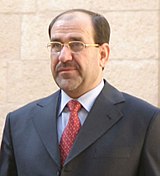2010 Iraqi elections
|
|
|||||||||||||||||||||||||||||||||||||
|---|---|---|---|---|---|---|---|---|---|---|---|---|---|---|---|---|---|---|---|---|---|---|---|---|---|---|---|---|---|---|---|---|---|---|---|---|---|
|
|||||||||||||||||||||||||||||||||||||
|
All 325 seats to the Council of Representatives 163 seats were needed for a majority |
|||||||||||||||||||||||||||||||||||||
|
|||||||||||||||||||||||||||||||||||||

Colours denote which party won the most votes in every governorate
|
|||||||||||||||||||||||||||||||||||||
|
|||||||||||||||||||||||||||||||||||||
Nouri al-Maliki
State of Law Coalition
Nouri al-Maliki
State of Law Coalition
A parliamentary election was held in Iraq on 7 March 2010. The election decided the 325 members of the Council of Representatives of Iraq who would elect the Iraqi Prime Minister and President. The election resulted in a partial victory for the Iraqi National Movement, led by former Interim Prime Minister Ayad Allawi, which won a total of 91 seats, making it the largest alliance in the Council. The State of Law Coalition, led by incumbent Prime Minister Nouri Al-Maliki, was the second largest grouping with 89 seats.
Prior to the election, the Supreme Court in Iraq ruled that the existing electoral law/rule was unconstitutional, and a new elections law made changes in the electoral system. On 15 January 2010, the Independent High Electoral Commission (IHEC) banned 499 candidates from the election due to alleged links with the Ba'ath Party. Before the start of the campaign on 12 February 2010, IHEC confirmed that the appeals by banned candidates had been rejected and thus all 456 banned candidates would not be allowed to run for the election.
The turnout was low (62.4%, see section Results) compared to the elections of 2005 (79.6%). There were numerous allegations of fraud, and a recount of the votes in Baghdad was ordered on 19 April 2010. On 14 May IHEC announced that after 11,298 ballot boxes had been recounted, there was no sign of fraud or violations.
The new parliament opened on 14 June 2010. After months of fraught negotiations, an agreement was reached on the formation of a new government on 11 November. Talabani would continue as president, Al-Maliki would stay on as prime minister and Allawi would head a new security council.
The necessary election law was only passed on 8 November 2009, and the UN Mission in Iraq, which is helping with the elections, estimated that it needed 90 days to plan for the election. The electoral commission asked for a delay from the original date of 15 January. Iraqi Vice President Tariq Al-Hashimi vetoed the election law on 18 November 2009, delaying the election, which was originally scheduled for 21 January.
...
Wikipedia



